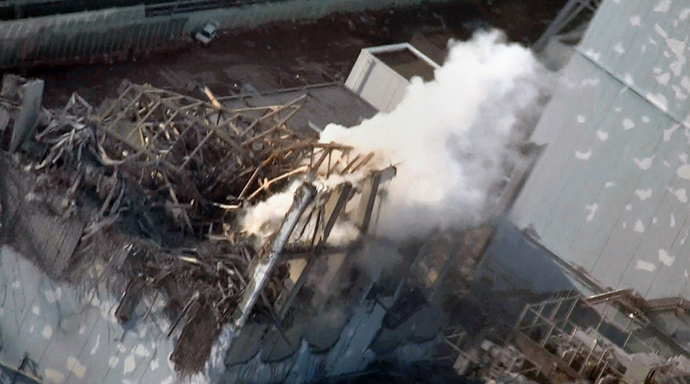RT
August 17, 2013

Even the tiniest mistake during an operation to extract over 1,300 fuel rods at the crippled Fukushima nuclear power plant in Japan could lead to a series of cascading failures with an apocalyptic outcome, fallout researcher Christina Consolo told RT.
Fukushima operator TEPCO wants to extract 400 tons worth of spent fuel rods stored in a pool at the plant’s damaged Reactor No. 4. The removal would have to be done manually from the top store of the damaged building in the radiation-contaminated environment.
In the worst-case scenario, a mishandled rod may go critical, resulting in an above-ground meltdown releasing radioactive fallout with no way to stop it, said Consolo, who is the founder and host of Nuked Radio. But leaving the things as they are is not an option, because statistical risk of a similarly bad outcome increases every day, she said.
RT: How serious is the fuel rod situation compared to the danger of contaminated water build-up which we already know about?
Christina Consolo: Although fuel rod removal happens on a daily basis at the 430+ nuclear sites around the world, it is a very delicate procedure even under the best of circumstances. What makes fuel removal at Fukushima so dangerous and complex is that it will be attempted on a fuel pool whose integrity has been severely compromised. However, it must be attempted as Reactor 4 has the most significant problems structurally, and this pool is on the top floor of the building.
There are numerous other reasons that this will be a dangerous undertaking.
– The racks inside the pool that contain this fuel were damaged by the explosion in the early days of the accident.
– Zirconium cladding which encased the rods burned when water levels dropped, but to what extent the rods have been damaged is not known, and probably won’t be until removal is attempted.
– Saltwater cooling has caused corrosion of the pool walls, and probably the fuel rods and racks.
– The building is sinking.
– The cranes that normally lift the fuel were destroyed.
– Computer-guided removal will not be possible; everything will have to be done manually.
– TEPCO cannot attempt this process without humans, which will manage this enormous task while being bombarded – with radiation during the extraction and casking.
– The process of removing each rod will have to be repeated over 1,500 times without incident.
– Moving damaged nuclear fuel under such complex conditions could result in a criticality if the rods come into close proximity to one another, which would then set off a chain reaction that cannot be stopped.
What could potentially happen is the contents of the pool could burn and/or explode, and the entire structure sustain further damage or collapse. This chain reaction process could be self-sustaining and go on for a long time. This is the apocalyptic scenario in a nutshell.
The water build-up is an extraordinarily difficult problem in and of itself, and as anyone with a leaky basement knows, water always ‘finds a way.’
‘Trivial in light of other problems at Fukushima, water situation could culminate in the chain reaction scenario’
At Fukushima, they are dealing with massive amounts of groundwater that flow through the property, and the endless pouring that must be kept up 24/7/365 to keep things from getting worse. Recently there appears to be subsidence issues and liquefaction under the plant.
TEPCO has decided to pump the water out of these buildings. However, pumping water out of the buildings is only going to increase the flow rate and create more of these ground issues around the reactors. An enormous undertaking – but one that needs to be considered for long-term preservation of the integrity of the site – is channelling the water away, like a drain tile installed around the perimeter of a house with a leaky basement, but on an epic scale.
Without this effort, the soils will further deteriorate, structural shift will occur, and subsequently the contents of the pools will shift too.
 Daily Stormer The Most Censored Publication in History
Daily Stormer The Most Censored Publication in History


